In-Depth Look at Lumix G85 Specifications and Features
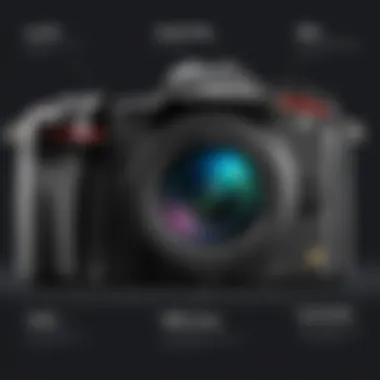
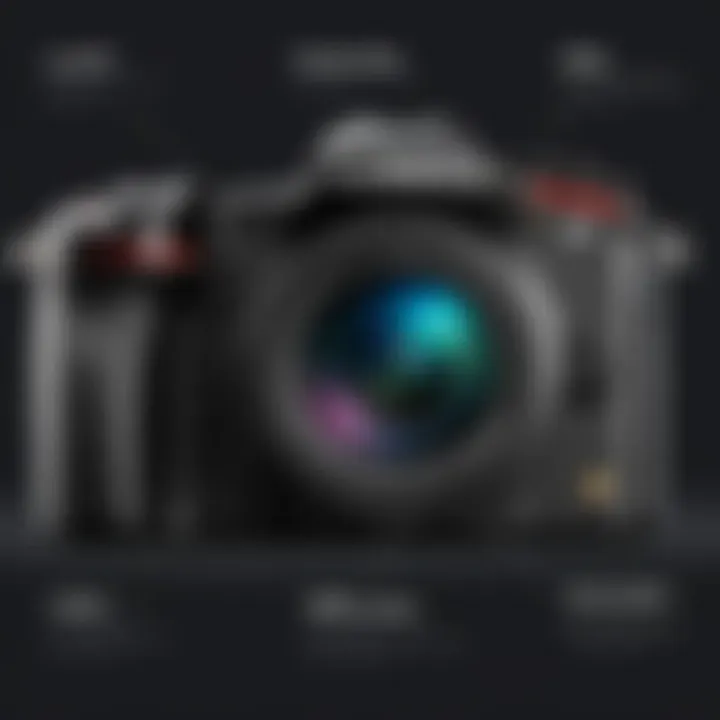
Intro
In today's competitive camera market, understanding the specifications of a device like the Lumix G85 is essential for enthusiasts and professionals alike. This section sets the stage for a detailed exploration of its features, performance, and practical usability. The Lumix G85, developed by Panasonic, stands out through its innovative technology, making it an appealing choice for photographers and videographers seeking both quality and versatility.
Overview of the Technology
Key specifications
The Lumix G85 incorporates a Micro Four Thirds sensor, offering a resolution of 16 megapixels. Its notable characteristics include:
- 5-axis dual image stabilization: Enhances image clarity even in challenging conditions.
- ISO range: 200 to 25600, allowing for exceptional performance in low light.
- 4K video recording: Captures video at 30 frames per second, providing crisp quality.
- Weather-sealed body: Protects the camera from dust and moisture.
These specifications position the G85 as a robust option for diverse shooting scenarios.
Unique selling points
One of the standout features of the Lumix G85 is its dual image stabilization. This technology significantly reduces blur caused by camera shake. Additionally, the camera’s 4K functionality not only allows for high-resolution video capture but also offers the unique feature of 4K photo, which extracts still images from 4K video clips. This versatility is appealing to users who require flexibility in their photography tasks.
Another selling point is the camera's design, which is tailored for both comfort and usability, making it accessible for newcomers while still delivering advanced features for seasoned photographers.
Design and Build Quality
Material used
The Lumix G85 features a combination of magnesium alloy and polycarbonate materials. This construction ensures durability without adding excessive weight, enhancing portability for users who travel frequently. The weather-sealed body safeguards internal components against the elements, making it suitable for outdoor photography.
Ergonomics and usability
The camera's ergonomics are carefully designed for prolonged use. The grip is comfortable, allowing the user to maintain hold for extended periods. Controls are intuitively placed, facilitating accessibility when changing settings in dynamic shooting environments.
The vari-angle touchscreen adds versatility. Users can adjust angles for creative compositions, promoting user experimentation.
"The Lumix G85 strikes a balance between advanced features and ease of use, appealing to both novice and experienced photographers."
Culmination
The specifications of the Lumix G85 demonstrate a well-rounded camera tailored to meet the needs of both casual shooters and dedicated professionals. By understanding its technical aspects, potential buyers can make informed decisions regarding their photographic and videographic pursuits. As the article progresses, each section will delve deeper into specific functionalities, providing insights that will assist in evaluating this camera in a crowded market.
Preamble to Lumix G85
The Lumix G85 is a mirrorless camera that combines advanced features with user-friendly operation. Understanding the introduction to this device is essential because it sets the stage for appreciating its specifications and performance. The G85 caters to both enthusiasts and professionals, offering a balanced blend of portability and capability. This overview emphasizes the significance of knowing the context and evolution of the Lumix brand, which contributes to the G85's unique position in the market.
Brief History of Lumix Cameras
The Lumix line of cameras, developed by Panasonic, began in 2001 with the introduction of compact digital cameras. Over the years, Lumix has evolved, integrating various technologies and responding to the needs of photographers. The Lumix G series was launched in 2008, marking Panasonic's entry into the mirrorless segment. This innovation allowed photographers to utilize interchangeable lenses while maintaining a lightweight design. Significant strides have been made in each new model, with features such as advanced autofocus, high-definition video recording, and enhanced image sensors becoming standard. The G85 represents a culmination of these developments, and its release was well-received due to improvements in stabilization and weather-sealing.
Positioning of the G85 in the Market
The Lumix G85 is strategically positioned in the market to appeal to serious photographers who desire more than just basic functionalities. It competes directly with other mid-range mirrorless cameras, like the Sony Alpha a6300 and the Nikon Z50. The G85 excels in delivering excellent image quality along with robust video capabilities, which attracts videographers as well. One of its defining features is dual image stabilization, which helps achieve sharp results even in challenging conditions. This feature, combined with a comprehensive set of controls and customizable options, underscores its appeal to users looking for versatility. Furthermore, the affordability of the G85 compared to similar models enhances its attractiveness to tech-savvy individuals who seek value without compromising performance. The careful balance of specifications and price makes the Lumix G85 a noteworthy option within the competitive landscape of mirrorless cameras.
Key Specifications Overview
The key specifications serve as the backbone of any camera evaluation. For the Lumix G85, these details are essential in understanding the technology underpinning its performance. When assessing a camera, the specifications can illuminate how well the device manages different photographic environments, from low light settings to fast-paced action shots. Additionally, they inform potential buyers about the unique features that set the camera apart in its category, helping them make informed decisions.
Sensor Type and Size
The Lumix G85 features a Micro Four Thirds sensor, which measures 17.3 x 13.0 mm. This sensor size is significant because it strikes a balance between portability and image quality. The Micro Four Thirds format allows for a compact camera body while still producing impressive results in various lighting conditions. The sensor type contributes to the overall dynamics of image capture, including depth of field and low light performance.
Image Processor Details
This camera is equipped with Panasonic's Venus Engine image processor. This processor is a crucial element in determining image quality and processing speed. It helps reduce noise at higher ISO settings, enhancing clarity in images taken under challenging conditions. Furthermore, the Venus Engine supports advanced technologies such as 4K video recording and high-speed autofocus, emphasizing the camera's versatility for both photographers and videographers.
ISO Range
The ISO range of the Lumix G85 spans from 200 to 25600. This range is noteworthy because it provides flexibility in various shooting situations. For users venturing into low-light environments, the higher ISO settings allow for clearer images with minimal noise, while the lower settings maintain fine detail and color accuracy in bright conditions. Having such a broad ISO range means the G85 can adapt to different lighting scenarios effectively.
Video Capabilities
Video recording on the G85 is robust, supporting 4K at 30 fps and 24 fps. Additionally, it includes Full HD 1080p modes at higher frame rates, which are useful for slow-motion footage. The camera also offers a variety of recording formats and options, giving creators flexibility in how they want to capture their stories. Furthermore, the option for V-LogL recording is available, providing a higher dynamic range and color grading potential during post-production.
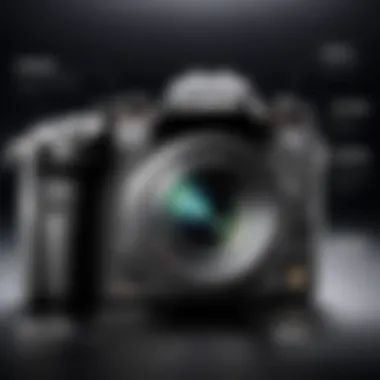

Autofocus System
The autofocus system in the Lumix G85 plays a crucial role in achieving sharp and clear images, which is essential for both photographers and videographers. In an era where image quality significantly influences the impact of a photo or video, the performance of autofocus directly affects user satisfaction. The Lumix G85 employs advanced autofocus technologies designed to lock onto subjects quickly and accurately, catering to various shooting styles and scenarios.
Type of Autofocus
The Lumix G85 utilizes a contrast-detection autofocus system, which is complemented by Panasonic's Depth from Defocus technology. This hybrid mechanism improves the speed and accuracy of lens focusing by analyzing out-of-focus data to calculate the optimal point of focus. This is beneficial in situations with varying lighting conditions or where precise focus is critical, such as portrait or macro photography. The camera's ability to consistently deliver accurate focus even under challenging conditions showcases its engineering excellence.
Number of Autofocus Points
With 49 autofocus points, the Lumix G85 offers a balance between coverage and precision. These points are distributed across the frame, allowing photographers to select their desired focal point swiftly. This flexibility is especially valuable when shooting fast-moving subjects or when precise composition is necessary. Users can rely on the camera's autofocus to track subjects reliably without losing critical moments, making the G85 suitable for dynamic shooting environments, such as events or wildlife photography.
Focus Speed and Accuracy
The sharpness of any image depends heavily on the speed and accuracy of its focus system. The Lumix G85 excels in focus speed, achieving a lock in mere moments. Whether dealing with still subjects or capturing fast action, the camera maintains its effectiveness. Importantly, the accuracy of the autofocus system is commendable, with minimal front or back focus issues. This direct correlation between focus speed and accuracy elevates the user experience, allowing for confident shooting across diverse scenarios.
"The autofocus system in the Lumix G85 is characterized by quick performance and strong accuracy, making it a reliable choice for serious photographers."
Overall, the autofocus system enhances the Lumix G85's abilities, driving home its appeal to tech-savvy individuals looking for a camera that marries performance with usability.
Build and Design Features
The build and design features of the Lumix G85 play a crucial role in its overall functionality and user acceptance. These aspects not only influence the aesthetic appeal but also affect the practical usability of the camera in various environments. A well-constructed camera should provide a balance between portability and robustness, ensuring it meets the needs of both amateur and professional photographers alike. The details in design may seem minor, but they can significantly enhance the user experience and accommodate diverse shooting scenarios.
Exterior Dimensions and Weight
The Lumix G85 has compact exterior dimensions at approximately 128 x 89 x 77 mm (5.04 x 3.50 x 3.03 inches), making it suitable for a variety of handheld operations. Weighing about 505 grams (1.11 lbs) with the battery and memory card included, this camera strikes a balance between sturdiness and lightweight design. A lighter camera is essential for long shoots or travel, as it reduces fatigue and eases handling. With this size and weight, you can easily fit the G85 into a camera bag without sacrificing much space.
Ergonomics and Handling
When exploring the ergonomics and handling of the G85, the focus is on how the design facilitates usability. The grip is designed to be comfortable, allowing for secure handling even during extended photography sessions. The button placement is intuitive, enabling quick access to essential functions without having to dig through menus. This thoughtful design minimizes disruptions in workflow, which is particularly beneficial in dynamic shooting conditions.
Some users may find the layout of controls initially challenging, but with a bit of practice, most will adapt quickly. The camera's body features a textured surface, enhancing grip and ensuring stability, especially when using larger lenses.
Weather Sealing and Durability
One of the Lumix G85's standout features is its ability to withstand harsh conditions, thanks to the weather sealing built into the design. This feature is particularly appealing to outdoor photographers who are often exposed to elements like dust and moisture. The camera boasts a splash-proof and dustproof construction, making it reliable for use in various settings. Users can shoot confidently in light rain or dusty environments, knowing that their equipment is protected.
"A camera's durability can often be the difference between getting that perfect shot or having to retreat due to the elements."
In summary, the build and design features of the Lumix G85 enhance its usability, making it a practical choice for various photographic situations. The careful consideration of dimensions, ergonomics, and durability demonstrates Panasonic's commitment to catering to the needs of its users.
Display and Viewfinder
The display and viewfinder are critical components in any camera system. They play a vital role in not only how a photographer or videographer composes their shots but also how they interact with the camera's menu systems and settings. In the case of the Lumix G85, a thorough understanding of its display and viewfinder features can enhance the shooting experience significantly. These features not only determine the camera's usability but also affect the precision with which images can be captured.
Screen Specifications
The Lumix G85 is equipped with a 3.0-inch vari-angle touchscreen LCD that offers 1,040,000 dots of resolution. This high-quality display allows for sharp and accurate previews of your images and menu navigations. The vari-angle design is particularly advantageous for achieving creative angles, as it can tilt and swivel, making it easy to shoot from high or low perspectives.
One important aspect of the LCD screen is its touch function. Users can tap the screen to focus on specific subjects, and even trigger the shutter release. This feature improves shooting efficiency and gives photographers a more dynamic way to interact with their subject. Another feature to note is the screen's ability to provide live view mode, which is essential for composing shots in real-time, particularly when dealing with challenging lighting conditions.
Additionally, the LCD includes a wide viewing angle. This feature provides clarity even when viewed from the side, making it easier to share your composition with others or adjust settings without having to twist or reposition the camera. The brightness can also be adjusted, allowing for improved visibility in bright daylight situations.
Electronic Viewfinder Features
The electronic viewfinder (EVF) of the Lumix G85 is another noteworthy element. It boasts a resolution of 2,360,000 dots, providing clear and detailed framing for your shots. With a refresh rate that is fast enough to provide a smooth viewing experience, this EVF offers real-time feedback, making it easier to keep track of moving subjects or adjust settings on the fly.
Furthermore, the EVF provides crucial information overlays that show exposure, aperture, and shutter speed in real-time, allowing photographers to make quick decisions without taking their eyes off the action. This is particularly beneficial in fast-paced shooting scenarios where every second is important.
One distinct advantage of the electronic viewfinder is its ability to simulate the final image. This means that adjustments made to exposure and white balance can be previewed in real time, allowing for better planning of shots.
Overall, the Lumix G85's display and viewfinder create an engaging and functional interface for users. Whether it’s the flexible LCD for varied angles or the highly detailed electronic viewfinder for precise composition, both elements work harmoniously to enhance the overall photography experience.
Connectivity Options
Connectivity options in modern cameras are critical for enhancing usability and streamlining the workflow for photographers and videographers. The Lumix G85 comes equipped with various connectivity features that allow seamless integration into different multimedia environments. These features not only allow for the efficient transfer of files but also enable remote shooting capabilities and instant sharing on social media platforms. Understanding these connectivity options helps users maximize the camera's potential and choose how they want to display their work.
Wi-Fi and Bluetooth Capability

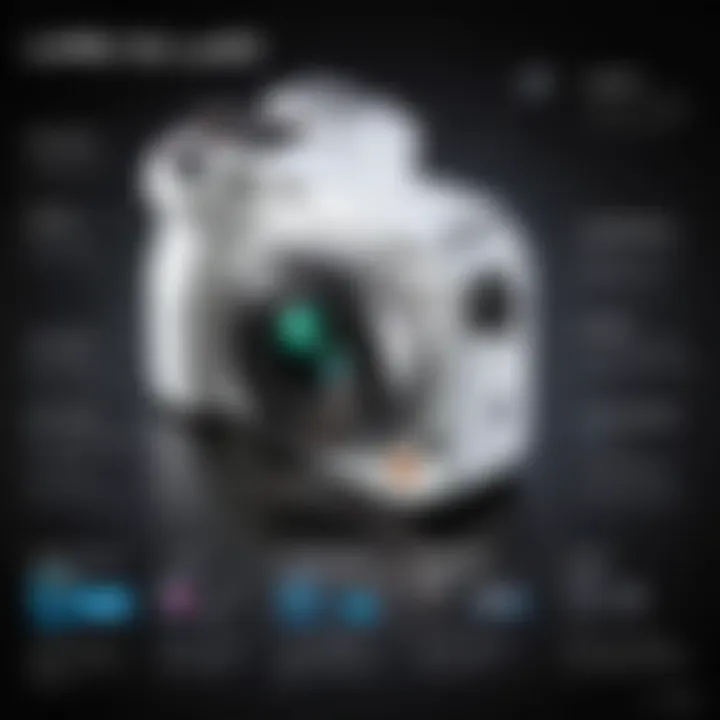
The Lumix G85 incorporates Wi-Fi and Bluetooth capabilities, providing versatile options for connectivity. The Wi-Fi feature allows for a direct connection to smartphones, tablets, or computers, making it easy to transfer images wirelessly. This is particularly useful for those who want to share photos quickly on platforms like Facebook or Instagram. The pairing of devices is straightforward, often requiring just a quick scan of a QR code from the camera.
Bluetooth, on the other hand, enhances connectivity further by enabling features like remote control and image transfer in a low-energy manner. This means that users can control their camera settings or trigger the shutter without being in direct proximity to the camera. As a result, it becomes easier to capture group shots or wildlife photography without disturbing the subjects. The combination of these wireless technologies makes the Lumix G85 a suitable tool for creators who prioritize both efficiency and minimal interruption when capturing content.
USB and HDMI Output
For those who prefer direct connections, the Lumix G85 offers USB and HDMI outputs, which serve different but complementary functions. The USB port facilitates direct file transfers to computers, ensuring faster, more stable data transfer, especially beneficial for larger files like 4K video. This is critical for videographers who work with high-definition footage and need a reliable connection for editing.
The HDMI output allows users to connect the camera directly to external monitors. This is particularly advantageous for live streaming or for anyone using the camera in a studio setting, where a larger display is necessary for monitoring purposes. With the HDMI port, users can achieve high-quality video output while also benefiting from the camera's advanced features.
Battery Performance
Battery performance is a crucial aspect to consider when evaluating the Lumix G85. A camera's battery life can greatly impact the overall shooting experience, especially for those engaged in long sessions without access to charging facilities. Understanding the battery's capacity and charging options can assist potential buyers in making informed decisions.
Battery Life Ratings
The Lumix G85 features a Lithium-ion battery, specifically the DMW-BLC12. This battery is rated for approximately 320 shots per charge under CIPA standards. While this number may seem modest, it’s important to recognize several factors that can affect real-world performance.
In practical usage, the actual number of shots taken can vary significantly. This assessment hinges on factors such as the frequency of image playback, the use of Wi-Fi connectivity, and the setting of the display. With efficient usage, some users report achieving around 500 shots per charge, especially when video recording is kept to a minimum.
- Battery Ratings: 320 shots approx (CIPA)
- Users’ Reports: Up to 500 shots with efficient usage
Understanding these ratings is vital. The G85 serves videographers alongside photographers, meaning battery demands can vary based on the type of activity being undertaken. A professional shooting video may find the battery draining much faster than when capturing stills. Thus, users need to plan their shooting sessions accordingly.
Charging Options
The G85 offers several charging options that enhance its usability in various scenarios. The most direct method is through the included AC adapter, which allows the user to charge the battery while keeping it in the camera. Additionally, a compact charger is also included that can be conveniently used for quick charges, making it a practical option for those on the go.
For more flexibility, the Lumix G85 supports USB charging as well. This allows the camera to be charged via a power bank, making it ideal for outdoor shoots. However, it is essential to note that USB charging can take more time compared to standard AC charging.
Key Charging Features:
- AC adapter for direct charging
- Compact charger for quick charging
- USB charging via power bank
Consideration of charging options can be essential for users who spend extended periods away from power sources. Knowing how and when to charge can mitigate potential issues before they arise, ensuring that the G85 is always ready for use.
In summation, understanding the battery performance of the Lumix G85 can significantly enhance the shooting experience. By being aware of the battery life ratings and charging options, users can optimize their camera usage and avoid interruptions during critical shooting moments.
Lenses and Accessories
Lenses and accessories play a crucial role in maximizing the capabilities of the Lumix G85 camera. They enhance the versatility, allowing photographers to adapt to various shooting conditions and creative demands. Understanding the types of compatible lenses and recommended accessories is essential for users aiming to elevate their photography experience.
Compatible Lens Types
The Lumix G85 uses a Micro Four Thirds lens mount. This compatibility opens up a wide array of options for photographers. Users can select from a variety of lens types, including:
- Prime Lenses: These lenses offer fixed focal lengths, enabling sharper images and better performance in low light.
- Zoom Lenses: These can cover a range of focal lengths, making them ideal for dynamic shooting environments where quick adjustments are necessary.
- Macro Lenses: Perfect for close-up shots, these lenses allow users to capture intricate details.
- Wide-Angle and Telephoto Lenses: For landscapes or distant subjects, these lenses are beneficial in expanding the camera’s shooting range.
Having access to different types of lenses helps users adapt to various shooting styles, from portraits to action shots, thereby improving their creative outcomes.
Recommended Accessories
Investing in accessories for the Lumix G85 enhances functionality and usability. Some recommended accessories include:
- Tripods: For stability during long exposures or video recording. Look for lightweight and sturdy options.
- External Microphones: Improve audio quality, especially for video recording, where built-in mics may not capture sound effectively.
- Lens Filters: Polarizing or ND filters can enhance outdoor photography, reducing glare and improving image quality.
- Camera Bag: A protective bag is vital for transporting gear efficiently, keeping everything organized and secure during travel.
- Extra Batteries: The G85’s battery life can be extended with additional batteries for long shooting sessions.
These accessories assist in optimizing the camera's potential while providing convenience and security during shoots. By considering both lenses and accessories, users can adapt the Lumix G85 to their specific photographic needs, significantly enhancing their overall experience with the device.
Software and Firmware
Software and firmware are critical components that significantly impact the overall performance and usability of the Lumix G85 camera. It's essential to understand how these elements enhance functionality and influence user experience. The software encompasses the camera's operating system and built-in applications, while the firmware refers to the software embedded within the hardware itself. Both play a pivotal role in optimizing features and ensuring smooth operation.
One of the key benefits of robust software in the Lumix G85 is its ability to provide users with advanced in-camera editing features. This capability allows photographers to make adjustments to images directly on the camera without the need for a computer. Such features can include cropping, color correction, and applying filters. This efficiency not only saves time but also allows for immediate feedback on how edits affect the final product. It is particularly attractive for photographers who wish to share their work rapidly on social media or with clients.
Another critical aspect of software and firmware lies in maintaining the camera's performance through regular updates. These updates can introduce new features, improve existing functionalities, and patch any software-related issues that might arise. The process of updating firmware is usually straightforward, requiring only a compatible memory card and a computer with internet access. Keeping firmware updated is crucial to ensure that the camera operates at its best and can adapt to new imaging technologies and standards.
In-Camera Editing Features
The Lumix G85 is equipped with an intuitive interface that allows users to edit images directly on the camera. This can be a huge advantage during events or travel, where immediate editing can lead to faster sharing. Key editing features available include:
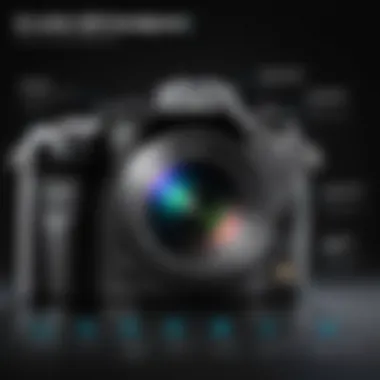
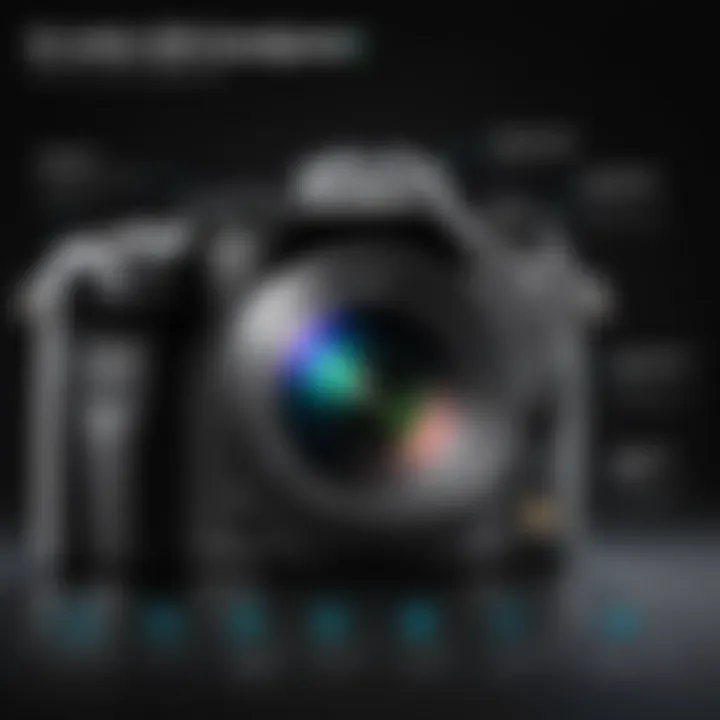
- Crop and Rotate: Users can quickly adjust framing without needing a computer.
- Color Adjustments: Fine-tune brightness, contrast, and saturation effectively.
- Filter Applications: Various filters can be applied to modify the image's style.
- RAW Processing: For those using RAW formats, in-camera processing can adapt the images closely to desired output.
These tools enhance creative control, enabling photographers to finalize images before they even reach a computer.
Firmware Update Processes
Firmware updates for the Lumix G85 are crucial to leverage new improvements and fixes. When new firmware is available, users are typically notified by the camera's interface or through the manufacturer's website. The update process usually follows these steps:
- Check for Updates: Regularly visit the Panasonic Lumix official website to find current firmware versions.
- Download the Update: Obtain the appropriate firmware version that matches the camera model.
- Prepare the Memory Card: Format or prepare a compatible memory card to store the firmware.
- Install the Update: Follow the on-screen instructions provided after inserting the memory card into the camera.
By keeping the firmware updated, users ensure the Lumix G85 continues to operate effectively and securely, minimizing bugs and enhancing overall functionality.
Regular updates not only improve performance but also ensure compatibility with newer accessories and lenses, enhancing the lifespan of the camera.
User Experience and Usability
User experience and usability are central to the satisfaction of any camera user, especially with a model like the Lumix G85. The way users interact with the device significantly affects their ability to capture moments effectively. This section focuses on essential elements that contribute to a smooth user experience, which includes navigation, interface clarity, and overall handling. By emphasizing these aspects, potential buyers can better evaluate how well the G85 suits their own photographic needs.
Learning Curve for Beginners
The Lumix G85 presents an intriguing proposition for beginners. The layout and design have been thought out with accessibility in mind. Beginners may feel overwhelmed by the myriad of settings and options available, but the user interface is relatively intuitive. The touchscreen allows for easy navigation through menus and settings, making it simpler for someone new to start. With practice, users can quickly familiarize themselves with key functions such as adjusting aperture and shutter speed.
Efficient guidance through in-camera tutorials aids new users in understanding various shooting modes. This path to proficiency typically involves initial challenges, yet many find the camera’s handling encouraging. Offering both automatic and manual modes caters to a range of skill levels, allowing beginners to grow and evolve over time.
Professional Use Cases
For professionals, the Lumix G85 is adaptable and reliable. It strikes a balance between advanced features and ease of use. Many professionals appreciate the camera’s versatility, making it suitable for different types of photography, from portraits to landscapes.
The high-quality 16 Megapixel Micro Four Thirds sensor is particularly appealing, providing excellent image quality under various conditions. Moreover, the G85 supports multiple aspect ratios and shooting formats, including RAW, which is often a requirement for professional work.
"The key to mastering any camera is consistent practice and familiarity with its features."
By acknowledging these important facets, potential users may find their decision-making process smoother.
Comparative Analysis
In evaluating the Lumix G85, understanding how it stacks against its competitors is essential. The comparative analysis sheds light on how this model measures up in the crowded field of mirrorless cameras. It not only helps potential buyers gauge the strengths and weaknesses of the G85 but also assists in making a more informed decision about their purchase. Examining similar models offers insights into performance, features, and pricing, guiding users to understand where the G85 fits in the landscape of camera technology.
Comparison with Competitive Models
The camera market is teeming with options, making it imperative to compare the Lumix G85 with notable alternatives. Cameras like the Sony Alpha a6300 and Canon EOS M50 are often discussed in the same breath as the G85. Each of these models has its own specification set and target audience, which adds to the complexity of choices.
- Sony Alpha a6300: This model boasts a faster autofocus system and superior high ISO performance. It excels in low-light conditions but often lacks the Ergonomics that G85 offers.
- Canon EOS M50: The M50 is user-friendly and has excellent color rendering. However, it may fall short in video capabilities compared to the G85, which offers more advanced features for videographers.
By making effective comparisons, prospective buyers can sift through critical factors, aligning their specific needs with the capabilities of each camera. Ultimately, the choice may come down to personal preference in handling, brand loyalty, and specific feature needs.
Price to Features Ratio
The Lumix G85 is positioned in a competitive price range, making its price-to-features ratio an important aspect of the purchase decision. Some cameras may be cheaper but might not deliver the same quality or versatility, while others may demand a premium for features that the G85 provides at a more reasonable price.
When analyzing this ratio, consider the following points:
- Pricing: The G85 typically sits in the middle of the market spectrum, appealing to both novice and serious photographers.
- Included Features: It includes dual image stabilization, 4K video, and a weather-sealed body — features that enhance its value proposition compared to many cheaper models.
- Long-term Investment: The G85’s robust build and capabilities suggest that it can be a long-term investment, reducing the need for future upgrades.
"In a saturated market, a thorough comparative analysis helps to illuminate the best options available for consumers, guiding them toward a wise investment."
Exploring options carefully ensures potential buyers can appreciate the nuances between models, allowing for a confident decision-making process.
Finale
In summing up the Lumix G85, various aspects converge to shape a valuable imaging tool for users at different levels. This article has dissected the specifications and features of the G85, revealing a thoughtful construction that caters to both enthusiasts and professionals. The camera delivers a robust performance in terms of image quality, versatility in video capture, and user-friendly features.
The importance of the conclusion lies in its ability to synthesize the discussed specifications and elaborate on how they translate into real-world usability. Understanding these elements helps clarify why the G85 holds relevance, especially for those looking for a bridge between casual photography and professional-grade results. Furthermore, it allows potential buyers to weigh the camera's attributes against their unique needs, encouraging informed decisions.
Final Thoughts
In the realm of mirrorless cameras, the Lumix G85 creates a niche for itself by offering a balanced combination of performance, durability, and ease of use. The dual stabilization feature stands out as a significant advantage, enabling excellent results in various shooting conditions. However, one must also recognize its limitations, such as the cropped 4K video and battery life that some professionals may find lacking. These aspects will ultimately impact a buyer's experience.
Recommendations for Potential Buyers
When considering the Lumix G85, it's important to reflect on a few crucial points:
- User Intent: Clarify whether your main focus is still photography or videography. The G85 excels in both areas but may have characteristics better suited for specific tasks.
- Enthusiasts and Beginners: This camera is particularly recommended for those who are entering the world of mirrorless systems or those upgrading from basic DSLRs. Its ergonomic design and intuitive interface can facilitate the learning curve.
- Accessories: Look into complementary lenses, like the Panasonic Lumix 12-60mm f/3.5-5.6, which maximizes the camera’s potential. Additionally, spare batteries may be necessary for extended shooting sessions.
By taking these recommendations into account, buyers can align their expectations and maximize their experience with the Lumix G85.







